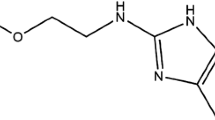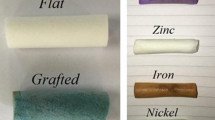Abstract
The adsorption of recombinant human-like collagen by metal chelate media was investigated in a batch reactor and in a fixed-bed column. The adsorption equilibrium and kinetics had been studied by batch adsorption experiments. Equilibrium parameters and protein diffusivities were estimated by matching the models with the experimental data. Using the parameters of equilibrium and kinetics, various models, such as axial diffusion model, linear driving force model, and constant pattern model, were used to simulate the breakthrough curves on the columns. As a result, the most suitable isotherm was the Langmuir–Freundlich model, and the ionic strength had no effect on the adsorption capacity of chelate media. In addition, the pore diffusion model fitted very well to the kinetic data. The pore diffusivities decreased with increasing the initial protein concentration, however had little change with the ionic strength. The results also indicated that the models predict breakthrough curves reasonably well to the experimental data, especially at low initial protein concentration (0.3 mg ml−1) and low flow rate (34 cm h−1). By the results, we optimized the experimental conditions of a chromatographic process using immobilized metal affinity chromatography to purify recombinant human-like collagen.






Similar content being viewed by others
Abbreviations
- a :
-
Specific surface area of particle (m2/m)
- C :
-
Protein concentration in bulk fluid phase (mg/ml)
- C 0 :
-
Initial protein concentration in bulk fluid phase (mg/ml)
- C * :
-
Equilibrium concentration in bulk fluid phase (mg/ml)
- C p :
-
Protein concentration in pore (mg/ml)
- D e :
-
Effective diffusivity (m2/s)
- D 0 :
-
Molecular diffusivity in free solution (m2/s)
- D p :
-
Pore diffusivity (m2/s)
- D z :
-
Axial dispersion coefficient (m2/s)
- F :
-
Volumetric ratio of solid phase to liquid phase
- K b :
-
Association constant in Langmuir isotherm
- k :
-
Constant in Freundlich isotherm
- K f :
-
Total transfer coefficient (m/s)
- k f :
-
Liquid film mass transfer coefficient on the particle surface (m/s)
- L :
-
Column length (m)
- Mr:
-
Molecular weight (kDa)
- n :
-
Constant in Freundlich isotherm
- q :
-
Adsorbed protein density (mg/ml)
- \(q_0^* \) :
-
q in equilibrium with C 0 (mg/ml)
- q m :
-
Adsorption capacity in Langmuir isotherm (mg/ml)
- \({\bar q}\) :
-
Adsorbent particle average concentration (mg/ml)
- R :
-
Mean particle radius (m)
- r g :
-
Radius of gyration of proteins (m)
- T :
-
Temperature (K)
- t :
-
Time (min)
- u :
-
Interstitial velocity (cm/h)
- V b :
-
Bed volume (ml)
- V L :
-
Volume of solution (ml)
- V S :
-
Volume of wet gel (ml)
- V v :
-
Bed void volume (ml)
- ɛ c :
-
Column void fraction
- ɛ p :
-
Effective intraparticle porosity for protein
- ρ :
-
Liquid phase density (kg/m2)
- μ L :
-
Viscosity of feed solution (Pa·s)
References
Calleja-Agius, J., Muscat, B. Y., & Brincat, M. P. (2007). Skin ageing. Menopause International, 13, 60–64. doi:10.1258/175404507780796325.
Olsen, D., Yang, C. L., Bodo, M., Chang, R., Leigh, S., Baez, J., et al. (2003). Recombinant collagen and gelatin for drug delivery. Advanced Drug Delivery Reviews, 55, 1547–1567. doi:10.1016/j.addr.2003.08.008.
Fan, D. D., Duan, M. R., Mi, Y., Song, J. R., Xi, J. F., Wang, D. W., et al. (2002). High density fermentation of recombinant E. coli for production of human-like collagen. Journal of Chemical Industry and Engineering (China), 53, 752–754.
Fan, D. D., Luo, Y. E., Mi, Y., Ma, X. X., & Shang, L. A. (2005). Characteristics of fed-batch cultures of recombinant Escherichia coli containing human-like collagen cDNA at different specific growth rates. Biotechnology Letters, 27, 865–870. doi:10.1007/s10529-005-6720-8.
Luo, Y. E., Fan, D. D., Ma, X. X., Wang, D. W., Mi, Y., Hua, X. F., et al. (2005). Process control for production of human-like collagen in fed-batch culture of Escherichia coli BL 21. Chinese Journal of Chemical Engineering, 13, 276–279.
Dalziel, J. E., Shu, S. W., Thai, P., Yan, L. Z., & James, D. (2007). Expression of human BK ion channels in Sf9 cells, their purification using metal affinity chromatography, and functional reconstitution into planar lipid bilayers. Journal of Chromatography. B, Analytical Technologies in the Biomedical and Life Sciences, 857, 315–321. doi:10.1016/j.jchromb.2007.07.033.
Hutchinson, M. H., & Howard, A. C. (2006). Adsorptive refolding of histidine-tagged glutathione S-transferase using metal affinity chromatography. Journal of Chromatography. A, 1128, 125–132. doi:10.1016/j.chroma.2006.06.050.
Lavanant, H., Emilie, H., & Yannik, H. (1999). Complexes of -histidine with Fe2+, Co2+, Ni2+, Cu2+, Zn2+ studied by electrospray ionization mass spectrometry. International Journal of Mass Spectrometry, 185–187, 11–23. doi:10.1016/S1387-3806(98)14044-7.
Yan, P. T., Tau, C. L., Wen, S. T., Khatijah, Y., & Beng, T. T. (2006). Recovery of histidine-tagged nucleocapsid protein of Newcastle disease virus using immobilised metal affinity chromatography. Process Biochemistry, 41, 764–881. doi:10.1016/j.procbio.2005.09.011.
Finzi, A., Cloutier, J., & Éric, A. (2003). Two-step purification of His-tagged Nef protein in native condition using heparin and immobilized metal ion affinity chromatographies. Journal of Virological Methods, 111, 69–73. doi:10.1016/S0166-0934(03)00154-X.
Kim, J. Y., & Cramer, M. S. (1994). Experimental studies in metal affinity displacement chromatography of proteins. Journal of Chromatography. A, 686, 193–203. doi:10.1016/0021-9673(94)00685-7.
Ozdural, A. R., Aslı, A., & Piet, J. A. M. (2004). Modeling chromatographic columns Non-equilibrium packed-bed adsorption with non-linear adsorption isotherms. Journal of Chromatography. A, 1041, 77–85. doi:10.1016/j.chroma.2004.05.009.
Wang, X. J., & Fan, D. D. (2005). Purification of recombinant human-like collagen by using metal chelated affinity chromatography. Journal of chemical engineering of Chinese universities, 19, 410–413.
Zhang, S. P., & Sun, Y. (2002). Ionic Strength dependence of protein adsorption to dye-ligand adsorbents. AIChE Journal. American Institute of Chemical Engineers, 48, 178–186. doi:10.1002/aic.690480118.
da Silva, E. A., Eneida, S. C., Celia, R. G. T., Lucio, C. F., & Reginaldo, G. (2002). Modeling of copper(II) biosorption by marine alga Sargassum sp. In fixed-bed column. Process Biochemistry, 38, 791–799. doi:10.1016/S0032-9592(02)00231-5.
Chen, W. D., Dong, X. Y., & Sun, Y. (2002). Analysis of diffusion models for protein adsorption to porous anion-exchange adsorbent. Journal of Chromatography. A, 962, 29–40. doi:10.1016/S0021-9673(02)00466-1.
Antonio, A. G., Matthew, R. B., Jaime, R. V., Mariam, S., & Anil, V. (2002). Bioseparation process science. Beijing: Tsinghua University Press.
Chen, W. D., Dong, X. Y., & Sun, Y. (2003). Dependence of pore diffusivity of protein on adsorption density in anion-exchange adsorbent. Biochemical Engineering Journal, 14, 45–50. doi:10.1016/S1369-703X(02)00118-3.
Chung, S. F., & Wen, C. Y. (1968). Longitudinal dispersion of liquid flowing through fixed and fluidized beds. AIChE Journal. American Institute of Chemical Engineers, 14, 857–866. doi:10.1002/aic.690140608.
Leitão, A., & Rodrigues, A. (1999). Modeling and simulation of protein adsorption in permeable chromatographic packings: a double linear driving force model. Biochemical Engineering Journal, 3, 131–139. doi:10.1016/S1369-703X(99)00011-X.
He, L. Z., & Niemeyer, B. (2003). A novel correlation for protein diffusion coefficients based on molecular weight and radius of gyration. Biotechnology Progress, 19, 544–548. doi:10.1021/bp0256059.
Umpleby, R. I., Baxter, S. C., Chen, Y., Shah, R. N., & Shimizu, K. D. (2001). Characterization of molecularly imprinted polymers with the Langmuir–Freundlich isotherm. Analytical Chemistry, 73, 4584–4591. doi:10.1021/ac0105686.
He, L. Z., Dong, X. Y., & Sun, Y. (1998). A diffusion model of protein and eluant for affinity filtration. Biochemical Engineering Journal, 2, 53–62. doi:10.1016/S1369-703X(98)00017-5.
Beasley, J. R., David, A. D., Tiffany, L. W., Susan, M. P., John, M. L., & Douglas, S. A. (2003). Evaluation of compound interference in immobilized metal ion affinity-based fluorescence polarization detection with a four million member compound collection. Assay and Drug Development Technologies, 1, 455–459. doi:10.1089/154065803322163768.
Carta, G., & Ubiera, A. (2003). Particle-size distribution effects in batch adsorption. AIChE Journal. American Institute of Chemical Engineers, 49, 3066–3073. doi:10.1002/aic.690491208.
Yang, H., & Etzel, M. R. (2003). Evaluation of three kinetic equations in models of protein purification using ion-exchange membranes. Industrial & Engineering Chemistry Research, 42, 890–896. doi:10.1021/ie020561u.
Acknowledgments
This work was supported by grants from the National Science and Technology Key Funds (2003DA901A32) and the National Natural Science Foundation (20476085 and 20606026).
Author information
Authors and Affiliations
Corresponding author
Rights and permissions
About this article
Cite this article
Wang, XJ., Fan, DD. & Luo, YE. Breakthrough Model of Recombinant Human-Like Collagen in Immobilized Metal Affinity Chromatography. Appl Biochem Biotechnol 158, 262–276 (2009). https://doi.org/10.1007/s12010-008-8351-8
Received:
Accepted:
Published:
Issue Date:
DOI: https://doi.org/10.1007/s12010-008-8351-8




